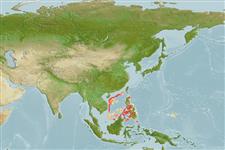Classification / Names
Common names from other countries
Main reference
Size / Weight / Age
Max length : 25.0 cm TL male/unsexed; (Ref. 13673)
Environment
Marine; bathydemersal; depth range 514 - 1344 m (Ref. 13673)
Climate / Range
Deep-water, preferred ?; 22°N - 4°N
Distribution
Short description
Dorsal
spines
(total): 2;
Dorsal
soft rays
(total): 160-163. Gill rakers on inner side of first arch 9-11. Scales below midbase of first dorsal fin, 3-5.5; below origin of second dorsal fin, (4-6)+1+(7-10) or a total 12-15. Suborbital width 2.8-4.1 into orbit diameter. Barbel 4.3-7.4. Scales between the first dorsal and lateral line with 9-12 spinules. Scales absent or in narrow patch on gular membrane; absent or a few isolated ones near anterior end on branchiostegal membranes. Adult size small, not longer than 25 cm TL (Ref. 13673).
IUCN Red List Status (Ref. 115185)
Threat to humans
Harmless
Human uses
More information
Common namesSynonymsMetabolismPredatorsEcotoxicologyReproductionMaturitySpawningFecundityEggsEgg development
Age/SizeGrowthLength-weightLength-lengthLength-frequenciesMorphometricsMorphologyLarvaeLarval dynamicsRecruitmentAbundance
ReferencesAquacultureAquaculture profileStrainsGeneticsAllele frequenciesHeritabilityDiseasesProcessingMass conversion
Tools
Special reports
Download XML
Internet sources
Estimates of some properties based on models
Phylogenetic diversity index
PD50 = 0.5156 many relatives (e.g. carps) 0.5 - 2.0 few relatives (e.g. lungfishes)
Trophic Level
3.4 ±0.5 se; Based on size and trophs of closest relatives
Resilience
Medium, minimum population doubling time 1.4 - 4.4 years (Preliminary K or Fecundity.)
Vulnerability
Low to moderate vulnerability (33 of 100)
Price category
